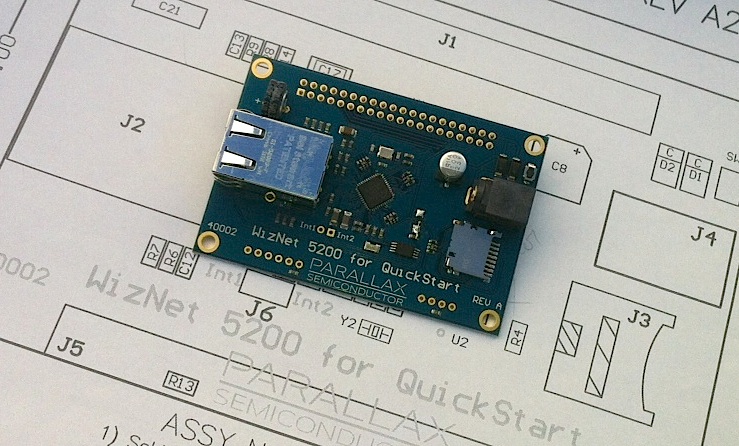WizNet5200 for QuickStart
 Ken Gracey
Posts: 7,419
Ken Gracey
Posts: 7,419
Hey all,
I could get in a lot of trouble with our marketing crew for making this post, so hopefully they don't see it. But I think it's important to share early since it's a product that was derived from serious community involvement, picking up where the Spinneret left off (and no, it won't be EOL'd). We can thank the collaboration between Tom Cantrell (Microfuture), David Kim (WizNet USA), MikeG, Nick McClanahan (Gadget Gangster), and a long list of 45 Parallax people for bringing this one to market. Why so many people? They each have a special role to make this one a success!
What is it? A fully-functional reference design to connect your Propeller to the internet. Send e-mail, serve a web page, and control the Propeller I/Os over the web. And it's a high-speed circuit around the W5200. How does it do it? Easily! Thanks to the programming giants, people like myself can just modify the top level file to do what we want to do. You've seen the hard work be accomplished on several threads in these forums, and probably contributed yourself (I'll ask MikeG to identify contributors so I can send them one of these for free). Thank you to everybody who has contributed to the objects underneath.
This obviously has a bunch of uses. For production customers, we want to support their Propeller product designs with quick-development efforts by adding internet control to their designs. It's a common request among our top customers with products in renewable energy, user-interface systems, and automation so they should be happy. And WizNet is a fine partner to provide this chip. It's available at a very low price from your favorite big distributors.
There's a Parallax Semiconductor AppNote in process, to be released before Christmas with the hardware.
And this design is open-source. I don't know the price of the board yet.
Thanks,
Ken Gracey

I could get in a lot of trouble with our marketing crew for making this post, so hopefully they don't see it. But I think it's important to share early since it's a product that was derived from serious community involvement, picking up where the Spinneret left off (and no, it won't be EOL'd). We can thank the collaboration between Tom Cantrell (Microfuture), David Kim (WizNet USA), MikeG, Nick McClanahan (Gadget Gangster), and a long list of 45 Parallax people for bringing this one to market. Why so many people? They each have a special role to make this one a success!
What is it? A fully-functional reference design to connect your Propeller to the internet. Send e-mail, serve a web page, and control the Propeller I/Os over the web. And it's a high-speed circuit around the W5200. How does it do it? Easily! Thanks to the programming giants, people like myself can just modify the top level file to do what we want to do. You've seen the hard work be accomplished on several threads in these forums, and probably contributed yourself (I'll ask MikeG to identify contributors so I can send them one of these for free). Thank you to everybody who has contributed to the objects underneath.
This obviously has a bunch of uses. For production customers, we want to support their Propeller product designs with quick-development efforts by adding internet control to their designs. It's a common request among our top customers with products in renewable energy, user-interface systems, and automation so they should be happy. And WizNet is a fine partner to provide this chip. It's available at a very low price from your favorite big distributors.
There's a Parallax Semiconductor AppNote in process, to be released before Christmas with the hardware.
And this design is open-source. I don't know the price of the board yet.
Thanks,
Ken Gracey



Comments
Somewhere along the line, there needs to be an RTC on one of the Quickastar boards....just saying. It never hurts to know the time!!
"Does any really know what time it is?
Does anyone really care? ('bout the time)"
As for RTC, you could use a Cog and initialize/calibrate/correct by getting the time from the net.
@twc hahahha , i just saw your post after I already posted .
The QS has turned out to be a versatile base board for various extensions. I have fun with Jeff's Pocket Mini Computer, for example (just had to add his VGAplus to one of my QS boards and there you go). Must buy another QS btw..
-Tor